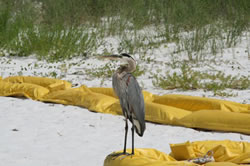Forests and Rangelands Success Story
Fire Managers Support Wildlife Recovery
U.S. Fish and Wildlife Service, Alabama, Florida, Louisiana, Mississippi, Texas
2010

Great Blue Heron rests on a boom placed on Gulf Island National Seashore to catch spilled oil expected to wash ashore. Photo by Warren Bielenberg.
Fire managers are among more than 495 FWS employees helping protect 36 national wildlife refuges from impacts of the Deepwater Horizon Oil Spill in the Gulf of Mexico. Arriving from across the country, they are supporting biologists with wildlife recovery and clean-up operations along the coast in Alabama, Florida, Louisiana, Mississippi, and Texas.
As specialists in incident planning, resource mobilization, and finance, fire managers are also operating as advisors on how to streamline the dispatching and payments processes, and how to develop and transition from the current emergency response to a long-term plan for wildlife recovery and clean-up.
Refuge managers also have the option to call upon firefighters to conduct “in-situ” burning of oil near or onshore, if needed to protect wildlife, as outlined in the FWS National Oil Spill Contingency Plan. However, FWS Southeast Regional Fire Management Coordinator, Bob Eaton, doesn’t think this will happen any time soon, because the oil on the shore would be difficult to ignite.
“ Oil has reached several National Wildlife Refuge lands in different forms,” noted Eaton. “Generally, by the time the oil reaches the shoreline, it has been diluted and is not a heavy crude concentrate. We have also seen small tar balls along the beaches. These conditions are less than favorable to implement a successful prescribed burn. In situ burning would not be very effective in these cases.”
Meanwhile, BP controlled burn teams based in Huoma, LA have successfully conducted more than 250 in-situ burns in open water since April 23, burning as estimated 6.23 million gallons of oil so far, according to BP reports as of June 21.
For more information, go to the FWS Deepwater Horizon Oil Spill Response website.